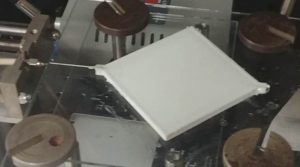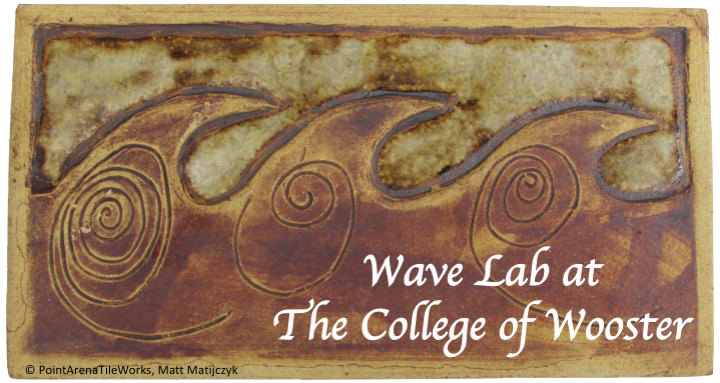Step 1 – water waves (2017 – 2018):
Step 2 – reaction-diffusion waves:

To avoid the experimental problems of the water waves systems, and to further scale the system down, Sam Nash ’19 used a two-dimensional reaction-diffusion-advection system in his 2019 Senior I.S. He replaced the water waves with chemical concentration waves in a Belousov-Zhabotinsky system which are much slower (about 3 mm/min) and, most importantly, will not reflect at walls. The system is also much smaller and now a real table-top experiment with dimension of about (15×15×0.58) cm3. Initiated circular waves (target pattern) in the fluid flow gradient (due to the varying flow area perpendicular to the flow – continuity equation) deform in the same way as water waves. Sam Nash designed and 3D-printed the new model and installed a new pumping system – after the previous system broke the summer before.
Sam Cavender continued during the summer 2019 by designing and testing the new system and the performance of the mold under various flow conditions (e.g., reducing the unwanted effect of printing undulations on the fluid flow).


Megan Fisher ’21 purchased a much better Gilson peristaltic pump through a Copeland fund and created a new mold with a constant width but varying height within the center section.
She tested all components of the new system, initiated wave through the hole, and observed the effect of the increasing flow rate on the BZ wave front.
During the Summer 2022, we also acquired a small CNC machine which we could utilize to create our own mold.
Senior Independent Study theses
- Megan Fisher ’21: Creating an Event Horizon Analogue with the Belousov-Zhabotinsky Reaction
- Sam Nash ’19: Using Belousov-Zhabotinsky waves as an analogue to the event horizon of a black hole
- Marc Manheim ’17: On the creation of a lab sized hydrodynamic event horizon analogue
NSF-REU Summer research
- Veran Stanek – Rochester Institute of Technology (2023): Modeling a Black Hole Event Horizon with a Light Sensitive Belousov-Zhabotinsky System
- Samuel Cavender – Georgia College & State University, Milledgeville, GA (2019): Belousov-Zhabotinsky waves as an analogue for a black hole event horizon
Poster presentations (click for more info)
- M. E. Manheim, J. F. Lindner, and N. Manz (2017) : “Experimentally modeling black and white hole event horizons via fluid flow”, APS March Meeting 2017, New Orleans, LA, USA, 2017 March 13-17
